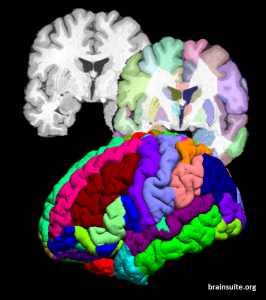BCI-DNI Brain Atlas Description
 The BCI-DNI_brain atlas was prepared using a high-resolution (0.5 mm × 0.5 mm × 0.8 mm) 3D MPRAGE scan of a right-handed adult woman in her mid-thirties, acquired at USC’s Dornsife Cognitive Neuroscience Imaging Center on a 3T Siemens MAGNETOM Tim Trio scanner. It is a brachicephalic brain.
The BCI-DNI_brain atlas was prepared using a high-resolution (0.5 mm × 0.5 mm × 0.8 mm) 3D MPRAGE scan of a right-handed adult woman in her mid-thirties, acquired at USC’s Dornsife Cognitive Neuroscience Imaging Center on a 3T Siemens MAGNETOM Tim Trio scanner. It is a brachicephalic brain.
The MPRAGE image was processed in a semi-automatic fashion using BrainSuite with meticulous manual corrections of the skull-stripping, cerebrum, and white-matter masks using the BrainSuite GUI interface and included a semi-automated bias field correction using the BFC Correction tool (http://neuroimage.usc.edu/neuro/Resources/bfc_correction_tool). All volumetric labels and sulci were drawn manually by Hanna Damasio, author of the human brain atlas, “Human Brain Anatomy in Computerized Images” (Oxford University Press, 2005) and Director of the Dornsife Cognitive Neuroscience Imaging Center (DNI) at the University of Southern California. The Sulcal Tracing Protocol [1] can be found here http://neuroimage.usc.edu/CurveProtocol.html.
The transfer of the volume labels to the surface mesh was done automatically using SVReg processes and hand-perfected using a Sulci-Surface Correction tool.
All extractions and manual corrections were performed by Soyoung Choi and approved by Hanna Damasio.
Image Acquisition
0.5 mm x 0.5 mm x 0.8 mm MPRAGE image. 384 x 384 x 192 matrix size with a 210 mm x 210 mm x 154 mm FOV
Regions of Interest:
95 ROIs are delineated on the volumetric labels of the atlas. 66 of these regions are labeled on the surface.
| superor frontal gyrus |
| middle frontal gyrus |
| pars opercularis |
| pars triangularis |
| pars orbitalis |
| pre-central gyrus |
| transvers frontal gyrus |
| gyrus rectus |
| middle orbito-frontal gyrus |
| anterior orbito-frontal gyrus |
| posterior orbito-frontal gyrus |
| lateral orbital gyrus |
| paracentral lobule |
| cingulate gyrus |
| subcallosal gyrus |
| post-central gyrus |
| supramarginal gyrus |
| angular gyrus |
| superior parietal gyrus |
| pre-cuneus |
| temporal pole |
| superior temporal gyrus |
| transverse temporal gyrus |
| middle temporal gyrus |
| inferior temporal gyrus |
| fusiforme gyrus |
| parahippocampal gyrus |
| hippocampus |
| amygdala |
| superior occipital gyrus |
| middle occipital gyrus |
| inferior occipital gyrus |
| lingual gyrus |
| cuneus |
| Insula |
| caudate nucleus |
| putamen |
| globus pallidus |
| nucleus accumbens |
| thalamus |
| inferior colliculus |
| superior colliculus |
| mamillary body |
| pineal |
| lateral ventricles |
| third ventricle |
| fourth ventricle |
| cerebral aqueduct |
| brainstem |
| corpus callosum |
| cerebellum |
Sulci:
26 sulci on each hemisphere are marked according to the BrainSuite curve protocol [1]. Details can be found at http://neuroimage.usc.edu/CurveProtocol.html
Additional sulci are marked on a second set of curves totaling 39 sulci on the left hemisphere and 37 sulci on the right hemisphere.
*indicates sulci described in the original BrainSuite curve protocol.
central sulcus*
precentral sulcus*
superior frontal sulcus*
inferior frontal sulcus*
ascending branch of the sylvian fissure*
horizontal branch of the sylvian fissure*
diagonal sulcus
lateral orbital sulcus*
frontomarginal sulcus*
cingulate sulcus*
paracentral sulcus*
superior supra orbital sulcus*
inferior supra orbital sulcus
olfactory or medial orbital sulcus*
H shaped sulci, mesial
H shaped sulci, lateral
H shaped sulci, transverse
sylvian fissure terminal split *
superior temporal sulcus*
inferior temporal sulcus*
occipito temporal sulcus*
collateral or medial occipito temporal sulcus*
transverse temporal sulcus*
circular sulcus*
postcentral sulcus*
intraparietal sulcus*
primary sulcus of Jensen
secondary sulcus of Jensen
parieto occipital sulcus*
subparietal sulcus*
calcarine sulcus*
calcarine sulcus terminal T
transverse occipital sulcus*
superior lateral occipital sulcus
inferior lateral occipital sulcus
anterior occipital sulcus
References:
[1] Pantazis D, Joshi AA, Jintao J, Shattuck DW, Bernstein LE, Damasio H, and Leahy RM, Comparison of landmark-based and automatic methods for cortical surface registration, NeuroImage, Vol. 49(3), pp 2479-2493, 2009.